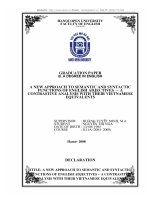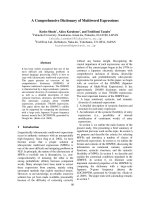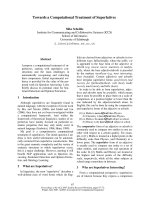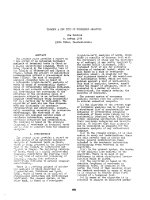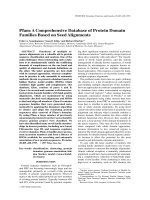TOWARDS A COMPREHENSIVE APPROACH OF SEXUAL AND REPRODUCTIVE RIGHTS AND NEEDS OF WOMEN DISPLACED BY WAR AND ARMED CONFLICT pptx
Bạn đang xem bản rút gọn của tài liệu. Xem và tải ngay bản đầy đủ của tài liệu tại đây (95.03 KB, 41 trang )
1
TOWARDS A COMPREHENSIVE APPROACH
OF SEXUAL AND REPRODUCTIVE RIGHTS
AND NEEDS OF WOMEN
DISPLACED BY
WAR AND ARMED CONFLICT
A Practical Guide for Programme Officers
Marleen Bosmans, Prof. Dr. Marleen Temmerman
International Centre for Reproductive Health, Ghent University
2003
With the support of the Flemish Interuniversity Council, VLIR.
2
Ghent, July 2003
ISBN: *
International Centre for Reproductive Health
Ghent University
De Pintelaan 185 P3
B-9000 Gent
Belgium
Tel.: +32 9 240 35 64
Fax: +32 9 240 38 67
E-mail:
Website:
This document is issued for general distribution. All rights are reserved. Reproductions and
translations are authorised, except for commercial purposes, provided the source is acknowledged.
3
With this we want to acknowledge
o Marleen Thomas, Leen De Becker, Carla Dauw and Tania Braems at the Belgian
Directorate General for Development Cooperation and Nicole Malpas at the
Belgian Technical Cooperation for their enthusiast cooperation and support
o Judy El-Bushra, Florence Tercier Holst-Roness, Samantha Guy, Wilma Doedens,
Gabriel Ojeda, Suad Abu-Dayyeh, Manuela Colombini and Henia Dakkak for their
critical and constructive comments at the international expert meeting in Ghent
o UNFPA-Jerusalem, the men and women of Juzoor and the women in the Jalazou,
Jabalyia and Amari Refugee Camps in the West Bank and the Gaza for their
warmhearted cooperation and hospitality during the field study in Palestine.
4
TABLE OF CONTENT
LIST OF ABBREVIATIONS 5
I. INTRODUCTION 6
II. PURPOSE AND USE OF THE GUIDE 8
1. Objectives 8
1.1. Overall Objective 8
1.2. Specific Objectives 8
1.3. Target Group 8
1.4. Process 8
1.5. Road Map 9
III. GUIDE 12
1. Conflict Analysis 12
2. Displacement 14
3. Stakeholders 16
4. Impact of the Conflict on the SRH Status of Women 18
4.1. Impact on the Political Environment 18
4.2. Impact on the Legal Environment 19
4.3. Impact on the Social and Cultural Environment 20
5. Provision of Comprehensive and High Quality SRH Services 22
5.1. Emergency Phase of Conflict 22
5.2. Stabilized Phase of Conflict 23
6. Conclusions and Recommendations 27
6.1. Conclusions 27
6.2. Recommendations 28
ANNEX 1 Glossary of Terms 29
ANNEX 2 ICPD and ICPD +5 Reproductive Health Indicators 33
ANNEX 3 Reference Addresses 36
ANNEX 4 Bibliography 39
5
LIST OF ABBREVIATIONS
AIDS Acquired Immunodeficiency Syndrome
CBO Community Based Organization
DGDC Directorate General for Development Cooperation
FP Family Planning
HIV Human Immunodeficiency Virus
IAWG Interagency-Working Group on Reproductive Health
in Refugee Situations
IDP Internally Displaced Person
IEC Information, Education, Communication
IUD Intra-uterine Device
MISP Minimum Initial Service Package
NGO Non-governmental organization
PHC Primary Health Care
RH Reproductive Health
SRH Sexual and Reproductive Health
STD Sexually Transmitted Disease
STI Sexually Transmitted Infection
UNHCR United Nations High Commisioner for Refugees
UNFPA United Nations Population Fund
VCT Voluntary Counselling and Testing
VAW Violence against Women
WHO World Health Organisation
6
I. INTRODUCTION
Since the International Conference on Population and Development (Cairo 1994) and
the Fourth World Conference on Women (Beijing 1995) the awareness about the
sexual and reproductive rights and needs of women affected by war and armed
conflict has been steadily growing. According to the definition given at the Cairo
conference reproductive health includes a wide variety of services such as family
planning, safe motherhood (including abortion – where legal –, prevention of abortion
and post-abortion care), prevention and care of sexually transmitted infections
including HIV/AIDS, education and counselling on human sexuality (with special
attention for violence against women) and active prevention of harmful practices,
such as female genital mutilation.
Although humanitarian aid programmes are paying more and more attention to the
provision of sexual and reproductive health (SRH) services, the development of a
comprehensive approach of SRH still constitutes a real challenge for donors,
international humanitarian agencies, national authorities, national and international
non-governmental organizations, and community based organizations.
The development of this guide is part of an interdisciplinary policy research for the
Belgian Development Co-operation into the sexual and reproductive rights and needs
of women displaced by war and armed conflict. The basic assumption of the guide is
that sexual and reproductive rights are human rights, and more specifically women’s
human rights, which are an inalienable, integral and indivisible part of universal
human rights. Taking this rights approach as a starting point the promotion and
protection of these rights should be considered in all humanitarian relief operations
and should be a priority of all SRH programmes.
A first draft of the guide was based on a preliminary literature review and desk study.
It was first tested in a field visit to the Palestinian Occupied Terrotiries. Subsequently
adapted versions were discussed with programme officers at the Belgian Directorate
General for Development Cooperation (DGCD) and at the First International Meeting
organised by UNFPA in Brussels for the Project on “Reproductive Health and Gender
Needs of Adolescent Internally Displaced Persons” (Brussels, 7-11 October 2002), a
programme supported by the Belgian DGCD. At the ICRH international expert
meeting on “Sexual and Reproductive Needs and Rights of Women Displaced by
War and Armed Conflict” (Ghent, 25-27 November 2002) the draft was peer
reviewed. A more final version was discussed during a lunch conference organized
by the Belgian Technical Cooperation.
As it happens, this kind of guides will always need continuous adapting and updating,
but we hope that it will be a useful tool for all involved in the development,
implementation , monitoring and evaluation of SRH humanitarian aid programmes in
paving the way for a more comprehensive, gender sensitive and culture sensitive
approach of displaced women’s SRH.
7
8
II. PURPOSE AND USE OF THE GUIDE
1. OBJECTIVES
1.1. OVERALL OBJECTIVE
The guide is meant as a tool for programme officers to support a comprehensive
approach of SRH rights and needs of women displaced by war and armed conflict.
1.2. SPECIFIC OBJECTIVES
? To get an overview of the key issues to be taken into account for a better
understanding of the impact of conflict on the SRH rights and needs of women
displaced by war and armed conflict.
? To assure a multidisciplinary, multisectoral and integrated approach of women’s
sexual and reproductive rights and needs by including legal, political, economical,
social, cultural and health aspects which determine women’s SRH status.
? To identify needs and gaps in the approach of sexual and reproductive rights and
needs of women displaced by war and armed conflict.
? To guide the development of comprehensive SRH programmes in conflict
situations within a long term perspective.
? To gain insight in the contribution of a specific SRH project to the improvement of
the SRH status of women displaced by war and armed conflict.
1.3. TARGET GROUP
This guide has been developed for programme officers in charge of humanitarian aid
programmes in SRH who are not necessarily medically trained and may not be
familiar with all aspects of SRH of refugees and internally displaced persons.
1.4. PROCESS
The development of comprehensive SRH services in conflict situations should be
seen as a process evolving from the delivery of emergency aid in SRH to the
planning of more sustainable SRH programmes as the situation stabilizes. Obviously
specific SRH projects may focus on only one or just a few aspects of SRH but they
should always be embedded in a coordinated effort to achieve a sustainable
improvement of the SRH of women displaced by war and armed conflict. The guide is
9
has been conceived as a tool 1) for screening SRH humanitarian aid programmes in
order to identify needs and gaps for reaching this goal; 2) for assessing the
contribution of specific projects to coordinated efforts in the field of SRH.
The guide focuses on the sexual and reproductive rights and needs of women in
emergencies and in the stabilized phase of conflict. It is divided into different
chapters comprising a series of topics concerning the different aspects that should be
taken into account. It does not only include medical aspects of SRH, but equally
emphasizes the need for the development of an enabling political, legal, economical,
social and cultural environment. The list of topics is not exhaustive and can be
adapted to each specific situation. It is mainly meant as a supportive and orienting
tool in discussions with the counterpart and other stakeholders involved in the
provision of SRH services in the context of humanitarian operations.
As the emphasis is on a comprehensive and coordinated approach, the formulation
of the conclusions should focus on the overall SRH related issues as well as on the
specific role and contribution of the counterpart in the kind of SRH services provided,
their quality, accessibility and affordability. These conclusions can be translated into
recommendations which may contribute to the development of strategies to enhance
full respect of displaced women’s sexual and reproductive rights and needs.
1.5. ROAD MAP
Ideally, the following steps should be taken when preparing field visits and meetings
with the different stakeholders.
1. Literature review
- Basic information on the conflict, the situation of
displacement.
- Basic information on the SRH status of women in the
country or region of origin.
- Basic information on the SRH provisions in the host
region or community.
- Policy documents, reports and publications of
stakeholders involved.
10
2. Identification of
stakeholders in
the provision of
SRH services
In principle a wide variety of stakeholders involved in SRH
programmes for refugee and internally displaced women
should be contacted such as:
- humanitarian organizations:
o active in the field of refugee health
o local, national as well as international
o preferably organizations working on one or more
aspects of SRH
- human rights organizations:
o active in the defense of human rights of
refugees/IDP, and more specifically of women’s rights
- women's organizations:
o women's organizations active in the refugee/IDP
communities
o committees and organizations of refugee/internally
displaced women themselves
- governments:
o local and national authorities responsible for
refugee/IDP settlement and care
- security forces:
o local, national and international forces responsible for
the security in and around the refugee/IDP
settlements
- others:
o other organizations and persons who may be able to
provide important insights in the SRH situation and
care for refugees/IDP in general, and for
refugee/internally displaced women in particular
(such as universities and research centres).
3. Programme
Organization of the mission agenda: meetings with the
stakeholders involved and visits to the displaced
communities.
4. Interviews
Semi-structured and open interviews with a representative
number of key informants among the broad scope of
stakeholders using the guide as a support for the
discussions.
5. Focus group
discussions
Semi-structured focus group discussions with displaced
women and health providers using the guide as a support.
11
6. Preliminary
conclusions and
recommendation
s
Formulation of preliminary conclusions and
recommendations on basis of the outcome of the literature
review, the interviews, the focus groups discussions and the
visits to the camps and settlements.
7. Feed back
Discussion of the preliminary conclusions and
recommendations at a joint meeting with representatives of
the counterpart and other directly involved stakeholders.
8. Report
Report of the field visit with final conclusions and
recommendations.
9. Dissemination
Dissemination of the report among the stakeholders
involved.
10. Strategy
formulation
Formulation of a joint strategy in close concertation with the
counterpart in order to develop a more comprehensive
approach of SRH of women displaced by war and armed
conflict.
12
III. GUIDE
1. CONFLICT ANALYSIS
Since the end of the Cold War there has been a dramatic increase in the number of
armed conflicts and wars, most of them taking place in developing countries and
more particularly in Least Developed Countries. In these countries the massive
displacement of people and the vast flow of refugees often provoke devastating
effects on the already scarce economic and natural resources and put a heavy
burden on the often precarious social and medical services. Moreover most conflicts
no longer take place between regular armies of recognized states but also involve
non-state actors, such as guerrilla organizations, armed rebel organizations and local
militia, with all sides intentionally targeting civilian populations and violating the
regulations of international humanitarian law.
In conflict and displacement different phases can be distinguished: 1) pre-conflict, 2)
conflict and emergency, 3) stabilization and 4) return and post-conflict. Each one of
these phases requires different kinds of interventions to be undertaken by
humanitarian organizations although phases may overlap and the transition between
one phase and the other is not always very clear.
When developing SRH programmes it is important to identify the specific
characteristics of the conflict that may seriously hamper the implementation of SRH
programmes for refugee and internally displaced women.
The following topics in a conflict analysis
1
should be considered:
1
REYCHLER Luc, Een wereld veilig voor conflict. Handboek voor vredesonderzoek., Garant, Leuven-
Apeldoorn, 1995 (p.215-288)
13
State of the
conflict
- Phase of conflict: pre-conflict phase, an emergency
situation, a protracted conflict or a post-conflict
situation.
- Degree of violence: kind of violence (conventional war,
terrorist war, guerrilla warfare), kind of weapons used.
- Kind of human destruction: casualties, injured,
traumatization, refugees, internal displaced persons,
main victims (military, civilians, ethnical groups; women,
elderly, children, young men).
- Kind of socio-economical destruction: damage to
infrastructure (buildings, houses, hospitals, roads,
energy supplies, transport).
- Kind of ecological destruction: drinking water supply,
agricultural production, mines.
- Geographical spread of the conflict: capital, main towns,
certain areas.
- Peace efforts: economical aid, peace keeping forces,
care for refugees and internally displaced persons, care
for injured persons.
Conflicting parties
- Number of parties.
- Kind of parties: conflicting states, military forces
(national, regional, international), guerrilla, paramilitary,
armed groups, armed civilians.
Causes
- Interests: political, economical power, territorial
autonomy
- Values: cultural, religious, ideological.
- Collective identity: ethnicity, nationalism
- Irrational: hatred, revenge, aggression.
14
2. DISPLACEMENT
Forced displacements of people and refugee movements are no longer side effects
of war and armed conflict but are increasingly used as tactics in war. Moreover, the
situation of refugees and IDPs is urging humanitarian organizations to revise their
policies and programmes and to reconsider them within a long-term strategy as there
is a strong tendency of conflicts to remain unsolved for many years.
A difference should also be made between refugees and internally displaced persons
(IDP). According to international humanitarian law, refugees cross national borders
and are protected by international legal standards. Internally displaced persons also
flee violence and conflict but as they stay within their country, they should be
protected by national legislation. On the whole IPS are subject to hostility of both the
hosting community and the public authorities. In very few countries IDPs are
registered though many people are reluctant to do so out of fear for persecution.
Refugee and IDP communities do not constitute homogeneous, a-political entities.
Refugees and IDPs carry their political ideologies, preferences and strives with them
and camps and settlements are often used as a battleground to continue power
struggles and fights. Camps can be open or closed. People can also live dispersed
among the host population and large self-settlements may gradually turn into camps.
Refugee and IDP camps and settlements are not necessarily safe-havens and are
often located in remote regions in the midst of or close to the conflict area often
hampering access of humanitarian relief aid.
Having a clear insight in the kind of displacement, the characteristics of the displaced
population and the organization of the displaced communities is extremely important
in order to be able to design appropriate SRH interventions.
The following topics should be considered
2
:
2
OJEDA Gabriel, MURAD Rocío, Salud Sexual y Reproductiva en Zonas Marginales. Situación de las Mujeres
Desplazadas.”, Asociación Probienestar de la Familia Colombiana PROFAMILIA, Bogotá, 2001 (p.9-42).
15
Displacement
- Causes (armed conflict, insecurity, forced displacement,
family reunion, employment, health, famine).
- Massive or individual.
- Place of origin.
- Migration movements.
- Duration.
Displaced
population
- Number.
- Socio-demographical characteristics (sex, age, civil status,
family composition, education, employment).
- Registration system.
- Access to social services, including SRH services.
- Special provisions for sole female headed households.
Living conditions
- Settlement (closed camps, open camps, refugee centres,
dispersed among hosting community).
- Housing (tents, slums, brick houses).
- Access to basic goods and services (water, food, fuel,
sanitary provisions).
- Measures to guarantee women’s access to basic goods
and services.
- Security and protection (presence of military forces, armed
groups, gangs, civil security patrols).
Management and
organization
- Institutions and authorities in charge (national,
international, governmental, non-governmental, community
based organizations).
- Organization of the displaced population.
- Organization of the displaced women.
- Participation of the displaced in the management.
- Active involvement of women in the management.
16
3. STAKEHOLDERS
The provision of comprehensive SRH services to displaced women in conflict
situations may involve different stakeholders including donors, international
institutions, governments, local authorities, national and international non-
governmental organizations (NGO) and local community based organizations (CBO).
At governmental level the organization of SRH programmes for displaced women
should not only be restricted to the participation of the Ministry of Health, but also
involve other Ministries such as the Ministry of Education (sexual education
programmes), the Ministry of Justice (gender based violence), the Ministry of Social
Affairs (social security and assistance to widows and sole female heads of
household) and even the Ministry of Defence (prevention of violence against women,
prevention of HIV/AIDS, security). In order to improve the efficiency and
effectiveness of the SRH humanitarian aid programmes, coordination among
stakeholders should be encouraged and supported, and more particularly
coordinating mechanisms for the improvement of the displaced women’s SRH should
be set up.
In view of a comprehensive approach of the sexual and reproductive rights and
needs of displaced women, the stakeholders community should not only include
organizations with a specific medical approach but should also include women’s
organizations and human rights organizations that promote and defend women’s
human rights, and more particularly women’s sexual and reproductive rights.
The following topics should be considered:
Identification
- Stakeholders involved in humanitarian aid for the displaced
population (donors, international organizations, national
and local authorities, international and national NGOs, and
CBOs including human rights and women’s organizations).
- Stakeholders involved in SRH humanitarian aid.
Coordination
- Coordinating mechanisms (members, mandate, objectives,
effectiveness, efficiency).
- Participation of national NGOs and authorities.
- Participation of national women’s and human rights
organizations.
- Participation and role of the counterpart in these
mechanisms.
17
SRH coordinating
mechanisms
-
- Specific mechanisms for coordinating SRH mechanisms
(members, mandate, objectives, effectiveness, efficiency).
- Participation of national NGOs and authorities.
- Participation of national women’s and human rights
organizations.
- Participation and role of the counterpart in these
mechanisms.
18
4. IMPACT OF THE CONFLICT ON THE SRH STATUS OF
DISPLACED WOMEN
4.1. IMPACT ON THE POLITICAL ENVIRONMENT
Conflict situations and massive displacement of people may seriously affect the
national and local health system. The kind and scope of SRH services that can be
provided in a certain setting are highly dependent on the national health policy in the
host country, and more particularly on the national protocol and guidelines on SRH of
the host country. These protocol and guidelines do not necessarily provide for all
SRH related services - including family planning (FP), safe motherhood, sexually
transmitted infections (STI) and HIV/AIDS, and violence against women.
SRH services for displaced women should always respect the existing health
structures, practices and policies of the host countries or the host community and
reinforce them where necessary. In this way humanitarian SRH interventions in
conflict situations may contribute to the development of a more integrated and
comprehensive SRH policy in the host country in the long term.
The following topics should be considered:
National health
policy
- National protocol and guidelines on SRH.
- Inclusion of SRH issues such as:
o safe motherhood: antenatal and postnatal care, safe
deliveries, emergency obstetric care.
o family planning: counselling and delivery of modern
contraceptives.
o STI/HIV/AIDS: prevention, treatment, care and support.
o gender-based violence: prevention, medical assistance,
psychosocial support, referral system for legal aid.
- Impact of the conflict/displacement on the implementation
(disruption of the policy implementation, initiation of new
programmes, reinforcement of ongoing programmes).
- International support.
19
Humanitarian
organizations,
national and
international
NGOs
- SRH policy (protocol, priorities, mandate).
- Compliance with national SRH policy.
- Support to development/reinforcement of national SRH
policy.
4.2. IMPACT ON THE LEGAL ENVIRONMENT
The promotion of women’s sexual and reproductive rights is fundamental for
improving women’s SRH. The awareness among stakeholders involved in the
provision of SRH services about the importance of women’s human rights, and more
particular of women’s sexual and reproductive rights, is gradually growing but is still
no real priority for most of them.
Women’s and human rights organizations which pay attention to women’s sexual and
reproductive rights can help to gain a better insight in the national regulations and
standards that affect the SRH of women, and more particularly the SRH of the
displaced women. Comprehensive SRH programmes for displaced women should
include support to advocacy and counselling efforts aimed at improving the legal
status of women as well as support to the development of a legal framework for the
protection of women’s sexual and reproductive rights.
The following topics should be considered:
Domestic law
-
Recognition of women’s rights as human rights in
domestic law.
-
Legal standards concerning SRH related issues such as:
marriage, widowhood, unwanted pregnancies, gender-
based violence, harmful traditional practices (such as
early marriage, female genital mutilation, dowry, honour
killings), support to HIV/AIDS infected.
Other legal systems
- Impact of customary law on displaced women’s SRH.
- Impact of tribal law on displaced women’s SRH.
- Impact of religious law on displaced women’s SRH.
20
Women’s rights
- Collaboration with human rights and women’s rights
organizations.
- Support to women’s rights and sexual and reproductive
rights initiatives (awareness raising, training, referral
system for legal aid and counselling, advocacy).
4.3. IMPACT ON THE SOCIO-CULTURAL ENVIRONMENT
Information about the social and cultural environment of displaced women’ SRH is
needed to gain a better insight in the social and cultural factors that affect the
displaced women’s SRH. Culture and customs affect women’s SRH in multiple ways
and are highly determinant for their SRH knowledge, needs, beliefs and attitudes.
They may also be a main cause of under-utilization of the SRH services provided. In
times of conflict and displacement women may become even more vulnerable in their
SRH as a result of their sex and changing gender-roles in society.
In many cultures the deployment of male health staff often constitutes a main
obstacle for women to attend the SRH facilities and the deployment of international
staff may be the cause of serious language and communication problems.
Active involvement of the displaced community, with special emphasis on the active
participation of women, in the needs assessment and the design of SRH services is
important to ensure that these services are gender sensitive and culturally
acceptable, and that they respond to women’s real needs and can rely on community
support.
The following topics should be considered:
SRH of displaced
women
- SRH knowledge, beliefs, attitudes and practices among
the displaced.
- Prevailing attitudes towards women’s sexuality.
- Taboos.
- Impact of the community.
- Impact of the family.
- Impact of prevailing gender-relationships: man-women,
boy-girl, elderly-young.
- Impact of changing gender-relationships.
- Impact of religion.
- Empowerment programmes (including economic
empowerment).
Harmful traditional
- Kind of harmful traditional practices (e.g. early marriage,
21
practices
female genital mutilation, widow marrying, dowry brides,
honour killing).
- Prevalence of harmful traditional practices.
Health staff
- Origin (international, national, local, members of the
displaced community).
- Knowledge of the language of the displaced.
- Knowledge, belief and attitudes towards prevailing SRH
practices.
- Efforts to employ and train female health staff.
- Efforts to employ and train members of the displaced
community.
- Training in cross-cultural skills.
- Gender-training.
Information-
Education-
Communication
(IEC)
- Participative approach (involving women, community
leaders, religious leaders).
- On prevailing taboos concerning SRH.
- On harmful traditional practices.
22
5. PROVISION OF COMPREHENSIVE AND HIGH QUALITY SEXUAL
AND REPRODUCTIVE HEALTH SERVICES
5.1. EMERGENCY PHASE OF CONFLICT
In emergencies only a limited range of SRH care services can be offered. Often
these services are limited to the reduction of maternal mortality and morbidity, but
other aspects of SRH such as the provision of modern contraceptives, prevention
and care of sexually transmitted infections (STI), including HIV/AIDS, and violence
against women (VAW) should not be neglected.
The Interagency-Working Group on Reproductive Health in Refugee
Situations(IAWG)
3
developed a “Minimum Initial Service Package” (MISP) for rapid
interventions in emergencies. This package has been designed as a set of activities
that can be implemented for:
1. the identification of organizations and individuals to facilitate co-ordination and
implementation of the MISP
2. the prevention and management of the consequences of sexual and gender-
based violence
3. the reduction of HIV
4. the prevention of excess neonatal and maternal morbidity and mortality
5. the planning of provisions for the development of comprehensive SRH
services integrated into primary health care as the situation permits.
For the launching of the MISP UNFPA developed a “Reproductive Health Kit of
Emergency Situations” (RH Kit). The kit consists of several sub-kits which can be
ordered separately for use at different levels (primary health care, health centre or
referral level, referral level).
4
3
The IAWG was established as an outcome of the Inter-agency Symposium on Reproductive Health in Refugee
Situations that took place in Geneva in 1995. The group was initially comprised of UNHCR, UNFPA and the
Reproductive Health for Refugees Consortium (RHRC) members and has been expanding ever since along with
the growing recognition for the importance of SRH issues in conflict situations. The IAWG was created to
ensure a better coordination and information sharing for various aspects of refugee reproductive health related
programming, monitoring and evaluation, as well as a tool development and research.
4
UNHCR, Reproductive Health in Refugee Situations. An Inter-agency Field Manual., 1999. The UNFPA
Reproductive Health Kit contains:
? For use at primary health care/health centre level: 10.000 population for three months:
0. Training and administration.
1. Condoms.
2. Clean delivery sets.
3. Post-rape management.
4. Oral and injectable contraceptives.
5. STD drugs.
? For use at health centre or referral level: 30.000 population for three months:
6. Professional midwifery delivery kit.
7. IUD insertion.
8. Management of the complication of unsafe abortion.
9. Suture of cervical and vaginal tears.
23
In emergencies the following topics in the provision of SRH services should be
considered:
Coordination
- Identification and employment of a SRH coordinator.
- Planning for the provision of comprehensive SRH services.
-
Tools
- MISP: knowledge, use and training.
- RH Kit: knowledge, use and training.
Basic SRH
services
- Prevention of excess neonatal and maternal morbidity and
mortality.
- Minimal supply of modern contraceptives.
- Free condom supply.
- Prevention of HIV/AIDS.
- Prevention of VAW.
- Assistance to victims of VAW.
-
5.2. STABILIZED PHASE OF CONFLICT
Once a refugee situation stabilizes it is important to expand SRH services beyond the
basic provisions. More comprehensive health care services can be provided and due
attention can be given to needs assessment, community participation, quality of care,
integration of services, information-education-communication activities (IEC),
advocacy and coordination among relief agencies.
A thorough needs assessment is basic for the further planning, implementation,
monitoring and evaluation of the services to be provided. This needs assessment
should not only include quantitative data, but also qualitative data on the displaced
population’s SRH. When doing the needs assessment the active participation of the
displaced community, and more particularly of the displaced women, is paramount.
Ideally refugees’ and IDPs SRH needs should be met as an integrated part of
primary health care and community services. Where refugees and IDPs live in
camps, clinics and outreach programmes should be established within the camps
and a reliable referral system should be organized and supported where necessary.
When refugees and IDPs live dispersed throughout the community the capacity of
the local health system should be supported and supplemented with additional
10. Vacuum extraction.
? For use at the referral level: 150.000 population for three months:
11. A – Referral-Level Surgical (reusable equipment).
11. B – Referral-Level Surgical (consumable items and drugs).
12. Transfusion (HIV testing for blood).
24
services such as counselling for post-traumatic stress disorder.
5
The SRH needs of
the host population should not be neglected neither and humanitarian SRH should
include them in their programmes where necessary.
Over the past years several guidelines, manuals and tools have been developed for
the implementation, monitoring and evaluation of SRH programmes for refugees and
IDPs. Serious efforts have been made to make these tools widely available but there
is still a huge need for having the development of comprehensive SRH programmes
to be accepted as a standard policy and practice in humanitarian aid operations.
In stabilized conflicts the following topics should be considered:
Needs assessment
- Quantitative needs assessment.
- Qualitative needs assessment.
- Participatory approach: active participation of
o the displaced community
o the displaced women
o “less visible” women (such as widows, sole female
heads of household, elderly women).
SRH services
- Participatory approach: active participation of the displaced
community and the women in the design.
- Efforts to strengthen the capacity of the local health system.
- Economical affordability (cheap, free of charge).
- Accessibility to the hosting community.
- Integration in primary health care centres (within the camp
in case of camp settlements)
- Outreach programmes.
- Referral system for emergency obstetric care.
- Transportation system to reach the referral centres
(organization, availability, efficiency).
- Continuous monitoring and evaluation.
5
Meeting the Reproductive Health Needs of Refugees. Outlook. Volume 17 Number 4,, UNFPA-PATH,
December 1999, 01/09/2001.
25
Equipment
- Material equipment.
- Basic laboratory equipment.
- Regular and reliable drug supply (including condoms and
modern contraceptives).
Staff
- Qualified and skilled staff (trained traditional birth
attendants, nurses, midwives, general practitioners,
obstetricians, gynaecologists).
- Regular training.
- Monitoring.
- Supervision
Safe Motherhood
- Antenatal care.
- Postnatal care.
- Breastfeeding.
- Skilled attendance of deliveries.
- Emergency obstetric care.
- Abortion (where legally permitted).
- Post-abortion care.
- IEC activities.
Family Planning
- Counselling.
- Availability of modern contraceptives (condoms, oral
contraceptives, injectables, IUD).
- Accessibility of modern contraceptives.
- Regular and reliable supply of modern contraceptives.
STI/HIV/AIDS
- Counselling.
- Treatment.
- Care.
- Support to HIV/AIDS infected.
- Voluntary Counselling and Testing (VCT).
- Safe blood supplies.
- IEC activities.
